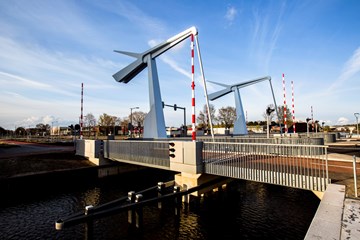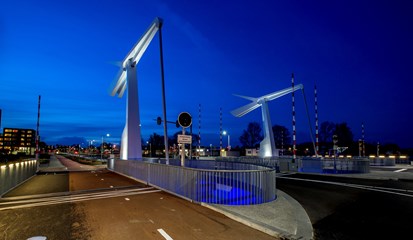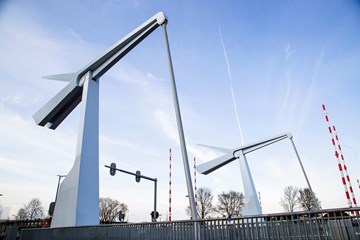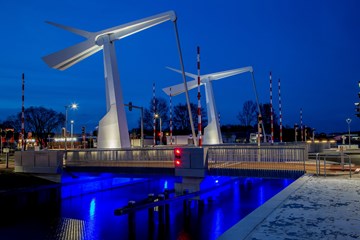Brug 'De Blauwe Klap', Assen
De Blauwe As
Het kanaal dat door Assen loopt had in de twintigste eeuw een industriële functie. De nieuwe toekomst ervan is die van Blauwe As, een ruime corridor van water waarlangs bewoners en bezoekers de stad en het landschap beleven, vanaf het land en vooral vanaf het water. Sluizen en bruggen worden vernieuwd of vervangen als onderdeel van de opwaardering van het kanaal. Om de vaarweg te herstellen was een nieuwe brug nodig die snel en makkelijk open kan om watersporters in de stad te verwelkomen. Deze brug, bij een van de belangrijkste kruispunten van de stad, moest een bekroning van de reeks bruggen over het kanaal worden. Een brug die niet alleen functioneel is, maar ook een blikvanger. Dat werd De Blauwe Klap, ontworpen door architectenbureau ZJA.
Een hedendaagse ophaalbrug
Slank en toch stevig, dat is het silhouet van de brug als je hem vanuit de verte ziet. Dichterbij gekomen vallen twee dingen op. Ten eerste de sobere en lichte vormgeving van wat toch enorme krachten en gewichten in bedwang houdt. En ten tweede de opvallende vormen van wat in lekentermen de armen met de contragewichten kan heten. In vaktermen heet zoiets de balanskist met balanspriem en dat geheel is hier gespleten in vieren, twee massieve balanskisten en erboven een gespleten balanspriem. Het lijken wel twee slanke vleugels. Rondom de brug is zo min mogelijk aandacht gevangen door verticale elementen, zodat de brug in volle glorie verschijnt als op een open plein.
Recht van voren, vanaf de weg, toont de brug zijn sterke en ingetogen gezicht. Vanaf het water gezien, van opzij, laat de Blauwe Klap de expressieve en speelse kant van het ontwerp zien.
Open en dicht
Als je toch moet wachten voor een brug die open gaat, dan is het goed als dat een opzienbarende en aantrekkelijke aanblik biedt. Dat is zo in het geval van de Blauwe Klap. Om te beginnen blijkt dat de fiets- en voetpaden een eigen dek hebben en er dus vier losse dekken de lucht in gaan, waartussen de hemel te zien is. Je kijkt naar iets loodzwaars dat gewichtloos lijkt. Dan is er het wonder van de hef-armen, zo vloeiend en elegant als ze zich oprichten. De onderdelen van het mechaniek vallen rondom het scharnier in elkaar en vormen eventjes een trots en uitbundig nuttig beeldhouwwerk, zomaar midden in Assen. Wie nu nog niet zijn ogen uitkijkt kan zich bij het wachten bezighouden met het lezen van het gedicht van de Assense dichter Lévi Weemoedt, dat op het rechtopstaande brugdek is geschilderd.
Om misverstanden te vermijden:
Dit is geen brug voor hoger opgeleiden
Een ieder mag er overheen
Mensen met scholing, mensen met geen
Mensen die rijk zijn of armoede lijden
Mensen die lopend zijn of rijden
De brug staat open voor iedereen
De omgeving
In het ontwerp van ZJA draait het niet alleen om het vernuft en de aanblik van de brug zelf. De hekken zijn zo vormgegeven dat ze verdwijnen als je er vanaf het water tegenaan kijkt, zo smal zijn de spijlen. Maar voor het verkeer dat de brug nadert werken dezelfde hekken als geleiders voor de aandacht, om helderheid over rijstroken en richting te versterken. Overdag heeft de brug een licht, zich trots en eigenzinnig boven de omgeving oprichtend uiterlijk. Na zonsondergang is de brug op straatniveau vanonder aangelicht en wordt er onder het brugdek een blauw schijnsel verspreid over het water, een combinatie die prettig en veilig is. Bij de aanlandingen van de brug is gezorgd voor extra ruimte, zodat zowel vanaf het land als vanaf het water een vrij zicht is en de manier waarop de Blauwe Klap zijn werk doet aan de Blauwe As optimaal kan worden beleefd.
Klant: Gemeente Assen
Opdrachtgever: Van Hattum en Blankevoort
Adviseurs: Royal HaskoningDHV en MEP:Vialis
[English]
The Blue Axis
The canal winding its way through the city of Assen had an industrial function for most of the twentieth century. In the twenty-first century it is envisioned as the Blue Axis, a spacious water corridor along which residents and visitors can experience the city and the landscape from the land and especially from the water. Locks and bridges will be replaced or renewed to upgrade the canal. In order to renovate the waterway a new bridge had to be built, one that could be opened quickly and easily to welcome pleasure boats into the city. This bridge, at one of the most important intersections in the city, was planned to be the highlight of a series of bridges over the canal. A bridge that was not only functional but a landmark as well. This resulted in The Blue Bridge (De Blauwe Klap), designed by architects ZJA.
A contemporary drawbridge
Slender yet sturdy is the impression the silhouette of the bridge gives when seen from a distance. Coming closer two aspects stand out. First, the minimal and light design that is still able to control the immense forces and weights. Secondly, the striking shapes of what the layman would call the counterweights. The professional terms are balance box and balance prong that appear here in four parts, two massive balance boxes and the split balance prongs. They look like two sets of slender wings. Around the bridge vertical elements demand little attention in order for the bridge to appear in its full glory as if on an open square.
From the front, from the road, the bridge appears strong and modest. Seen from the water however, from the side, the Blue Bridge shows the expressive and playful aspects of the design.
Open and closed
If you have to wait for the bridge to open, you might as well enjoy a remarkable and attractive view. That is the intention of the design for the Blue Bridge. When it opens it becomes apparent that the car and bicycle lanes have separate decks, so four separate decks go up between which a glimpse of sky can be seen. The sensation is watching something that is incredibly heavy yet seems weightless. Then there is the miracle of the drawbridge arms, so fluid and elegant as they right themselves. The elements of the mechanism fit into each other around the hinge and for as long as the bridge is upright perform the role of a proud, exuberant and useful sculpture, just like that, in the middle of Assen. Whoever is still not visually entertained can spend some time reading the poem printed on the up righted deck.
To avoid any misunderstanding:
This is no bridge built for educated types
Everybody may cross
People with an education, people without
People with money or those who are destitute
People on foot or sporting wheels
This bridge is up and open for all
The environment
This design by ZJA is not all about ingenuity and the looks of the bridge. The fences are designed to dissolve when viewed from the water, that is how narrow the bars are. For the approaching traffic however these same fences guide the attention in the right direction, for maximum clarity. During the day the bridge shows a light appearance that towers above the surroundings, proud and headstrong. After sundown the bridge is caught in upward aiming spotlight at street level while under the deck a blue diffuse light scatters across the water, creating a pleasurable and safe image. At the abutments extra space is created, in order to better enjoy an open view from the water and from the banks, and better appreciate the beauty and utility of the Blue Bridge over the Blue Axis.
Client: Gemeente Assen
Principal: Van Hattum en Blankevoort
Consultants: Royal HaskoningDHV and MEP:Vialis
Project partners
Related associations
Related projects
No results found
Did your company worked on this project? Go to the Public page and list yourself as a project partner to access your company only page
Which project partner should receive your project listing request?
Document generator
Thank you for using the document generator again! Click the button to start a free trial period of 5 documents.
Document generator
Your trial period has been expired. Please contact info@galleo.co.
Click the +Favorite button to add this project to your personal favorites





